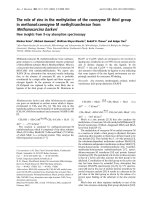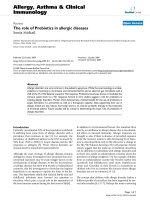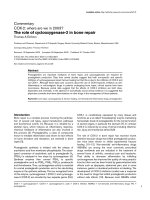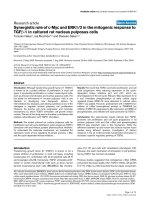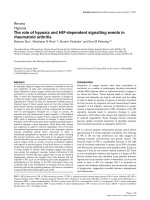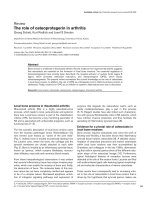Báo cáo y học: " Immunotherapeutic role of Ag85B as an adjunct to antituberculous chemotherapy" ppt
Bạn đang xem bản rút gọn của tài liệu. Xem và tải ngay bản đầy đủ của tài liệu tại đây (485.32 KB, 8 trang )
ORIGINAL RESEARCH Open Access
Immunotherapeutic role of Ag85B as an adjunct
to antituberculous chemotherapy
Javaid A Sheikh, Gopal K Khuller and Indu Verma
*
Abstract
Background: Immunotherapy to enhance the efficiency of the immune response in tuberculosis patients and to
eliminate the persisters could be an additional valuable strategy to complement anti-mycobacterial chemotherapy.
This study was designed to assess the immunotherapeutic potential of Ag85B as an adjunct to chemotherapy and
its effect against active and persister bacteria left after therapy in mouse model of tuberculosis.
Methods: 6-8 week old female Balb/c mice were infected with Mycobacterium tuberculosis and treated with
chemotherapy or immunotherapy. Protective efficacy was measured in terms of bacterial counts in lungs and
spleen. Immune correlates of protection in terms of Th1 and Th2 cytokines were measured by ELISA.
Results: Therapeutic effect of Ag85B was found to be comparable to that of short term dosage of antituberculous
drugs (ATDs). The therapeutic effect of ATDs was augmented by the simultane ous treatment with rAg85B and
moreover therapy with this protein allowed us to reduce ATD dosage. This therapy was found to be effective even
in case of drug persisters. The levels of antigen specific IFNg and IL-12 were significantly increased after
immunotherapy as compared to the basal levels; moreover antigen specific IL-4 levels were depressed on
immunotherapy with Ag85B.
Conclusion: We demonstrated in this study that the new combination approach using immunotherapy and
concurrent chemotherapy should offer several improvements over the existing regimens to treat tuberculosis. The
therapeutic effect is associated not only with initiating a Th1 response but also with switching the insufficient Th2
immune status to the more protective Th1 response.
Background
Major obstacle in control of tuberculosis being poor
patient compliance with the protracted regimen in areas
with limited resources which may lead to relapse of active
disease, transmission of infection and development of
drug resistant strains [1]. In such circumstan ces, immu-
notherapy to enhance the efficiency of the immune
response in M. tuberculosis infected pa tient s could be an
additional valuable strategy to complement anti-bacterial
chemotherapy. Even immunotherapy might shorten the
duration of treatment for drug- susceptible tuberculosis,
thereby reducing the cost and increasing treatment com-
pletion rates or might increase the cure rates in case of
MDR tuberculosis. In last dec ade, various nonspecific or
antigen specific immuno logical agents have been used
either alone or as an adjunct to chemotherapeutic regimen
with variabl e succ ess [2,3] such as, DNA plasmids [4 ,5],
detoxified M. tuberculosis extract in liposomes (RUTI) [6],
Mycobacterium vaccae [7], cytokines [8], Immunoglo bu-
lins [9], mycobacterial antigens [10] etc, to name a few.
Thus, considering the advancement in the field and keep-
ing in view the potential clinical aims, further research
on the concept of immunotherapy, or as an adj unct to
chemotherapy of tuberculosis, seems to be valuable.
Ag85B, a 30 kDa fibronectin-binding protein with myco-
lyltransferase activ ity, is a major protein secreted by all
mycobacterium species and belongs to the Ag85 family.
Ag85B is highly immunogenic, as shown by the easy
detection of specific humoral and cell-mediated immune
responses both in latently and actively infected TB patients
[11,12]. It has also been shown to induce a strong Th1-
type immune response in mice as well as in humans.
Several studies have shown a significant protective eff ect
in the lungs of mice immunized with Ag85B [13-16],
whereas a few contradic tory reports on the effic acy of
* Correspondence:
Department of Biochemistry, Postgraduate Institute of Medical Education
and Research, Chandigarh 160012, India
Sheikh et al. Journal of Immune Based Therapies and Vaccines 2011, 9:4
/>© 2011 Sheikh et al; licensee BioMed Central Ltd. This is an Open Access arti cle distributed under the terms of the Creative Commons
Attribution L icense ( which permits unrestricted use, distribution, and reproduction in
any medium, provided the original work is properly cited.
Ag85B protein vaccination have also been reported
[17-19]. Rec ently we reported the immunotherapeutic
effect of Ag85AB complex as a whole in mouse model
[10].
Analysis of the immunological mechanism in various
models suggest that the induction of Th1 immune
response including antigen-specific CD8
+
/CD4
-
/CD44
high
memory type cytotoxic T cells pro ducing IFNg,is
required for TB therapeutic vaccine efficacy in humans
as well [20-22]. Since DNA vaccines are known to estab-
lish cellular immune responses, including cytotoxic
T-lymphocyte (CTL) and Th1 responses, muc h interest
is being given to them. Their prophylactic behaviour
[15,17,23- 25] w as fo und t o be eff ective at limiting the
growth of M. tuberculosis in mice, but their therapeutic
use has been largely controversial [2].
Present study was carried out to b etter investigate the
immunotherapeutic eff ect of Ag85B protein and a D NA
vaccine based on this protein in mouse model of tubercu-
losis. Its adjunctive immunotherapeutic effect with simul-
taneous conventional chemotherapy and moreover its
effect on the persisters left after short-term, non-sterilizing
chemotherapy was also investigated. This was done with
the main objective of understanding the immunological
mechanisms involved in the therapeutic anti-TB immune
response.
Results
Therapeutic effect of the Ag85B protein and its DNA
vaccine
Mice infected with the M. tuberculosis H
37
Rv strain
were treated with ei ther rAg85B protein or Ag85B-DNA
(Figu re 1), and the therapeutic effects were expressed as
the bacterial load in the spleen and lung (Figure 2 &
Table 1 ). Compared with the adjuvant immunized con-
trol group, rAg85B significantly reduced the bacterial
numbers in the spleen and lung (p< 0.001), and was
equally effective to that of ‘short term’ chemotherapy.
The adjunctive effect of immunotherapy and chemother-
apy was much more pronounced as compared to adju-
vant immunized control group (p < 0.001) showing
effective cumulative effect on bacterial eradication
(Table 1). Although the effect was not additiv e as mar-
ginal decrease in CFU count was not statistically signifi-
cant when compared to ATD or IT alone. However no
significant reduction in CFUs with Ag85B-DNA immu-
notherapy was observed (data not shown). Further
efforts were made to mimic the process of chemother-
apy dosage reduction by delivery of drug dosage just
once a week with simultaneous immunotherapy and a
sig nificant reduction in CFU was observed as compared
to that of control (p< 0.01). These findings suggest that
immunotherapy could be effectively used as an adjunct
to chemotherapy and drug dosage can be considerably
reduced to once a week with concomitant immunother-
apy, as the CFU reduction was same as that of the
group where ATD was given daily (Figure 2).
Immunotherapeutic effect on persister bacteria
After the completion of conventional chemotherapy, the
bacteria that survive are usually persisters and in order
to check the efficacy of current immunotherapy on
those persisters, mice were administered a four week
dose o f chemotherapy to eliminate the drug susceptible
bacteria and then were subjected to immunotherapy.
Significant reduction in bacterial CFUs was observed as
compared to group where mice were adjuvant immu-
nized for 1 mo nth after chemotherapy; implying that
immunotherapy with Ag85B protein was effective in
inhibiting the persisters to regrow, that could resist the
‘short term’ chemotherapy (Figure 3).
Cytokine profile after Immunotherapy with rAg85B
The levels o f Th1 (IFNg and IL-12) and Th2 (IL-4) cyto-
kines were monitored before and after immunotherapy.
The levels of antigen specific IFNg and IL-12 were signifi-
cantly increased after immunotherapy as compared to that
of untreated group. Moreover, antigen specific IL-4 levels
declined upon immunotherapy with Ag85B (Figure 4). On
the contrary there was no significant level of antigen
induced cytokines in the mice receiving immunotherapy
with plasmid expressing Ag85B (data not shown).
Discussion
Immunotherapy that modulates or enhance s the host
immune response to M. tuberculosis has proven to be an
effective method for treatment of tuberculosis in mice
[26,27]. The long treatment course, along with the side
effects, often results in treatment failure. These limitations
together with the increasing incidence of drug resistant
strains and co infection with HIV point to an urgent need
for additional immunotherapeutic regimens [28,29].
Effective antimycobacterialimmunityispresumedto
be due to Th1 response, which is dominated by antigen-
specific T lymphocytes that produce IFNg and are cyto-
toxic towards infected cell s [20-22]. Th2 response char-
acterized by IL-4 production, which is predominant
during infection with M. tuberculosis, has been reported
to be non-protective in TB [20,30,31]. A shift in the bal-
ance towards Th1 response may be beneficial, laying
down a criterion for the selection of the antigens to be
protective in case of tuberculosis. Their prophylactic
behaviour being the guiding line for their probable ther-
apeutic use on basis of the principle ‘diamond cuts dia-
mond’ on the contrary to that of ‘adding fuel to the fire’.
Compared to antituberculosis drugs, the natural
immune response has a minor impact on mycobacterial
elimination during the early phase of therapy [32]. It is
Sheikh et al. Journal of Immune Based Therapies and Vaccines 2011, 9:4
/>Page 2 of 8
expected that immune modulation by immunotherapy
will lead to significant increase in the cure rates. The
present study involved the evaluation of immunothera-
peutic effect of rAg85B and a DNA vaccine expre ssing
this protein. Immunotherapy with rAg85B led to signifi-
cant decrease in bacteri al load in both lungs and spleen
which was comparable to that of short term chemother-
apy (Figure 2). A two log reduction observed in the
lungs of mice receiving immunotherapy with rAg85B
indicated it as an effective measure, as suggested by
Orme et al [3 3] according to which measures reducing
pulmonary bacterial loads by 0.7 logs are considered to
be effective. On the contrary, no such protection was
observed in case of pVAX85 . This absence of protection
in case of DNA vaccination is inconsistent with the
results from the published literature [26] but still,
though hard to justify, has supporting evidence [2].
Further, Ag85B immunotherapy, combined with short
term chemotherapy over 4 weeks showed a stronger
therapeutic effect than chemotherapy or immunotherapy
alone when compared to that of adjuvant immunized
control group (Table 1). Protective effect was still signif-
icant even when the chemotherapeutic dose was
reduced to once weekly instead of daily, thus suggesting
the possibility that immunotherapy including Ag85B
combined with chemotherapy might shorten the period
of conventional chemotherapy (Figure 2). However, a
time and antigen titration approach may determine an
optimal combined regimen sufficient to confer superior
therapeutic activity.
In this study a short dose of non-sterilizing chemother-
apy was administered so that only drug susceptible bac-
teria are eli minated. The persisters left out were treated
with rAg85B immunotherapy and a significant reductio n
in persister bacterial count was observed (Figure 3). These
findings suggest utility o f Ag85B based i mmunotherapy
against regrowth of persisters which are the major cause
of protracted drug treatment and even relapse of active
Chemotherapy daily
Immunotherapy weekly
Basal
CFU/IR
1 2 3 4 5 6 7 8 9 (weeks)
H
37
Rv
CFU/IR
H
37
Rv
Chemotherapy daily
CFU/IR
Immunotherapy weekly
1 2 3 4 5 6 7 8 9 10 11 12 (weeks)
Basal
CFU/IR
Figure 1 Time line representation of the experimental design. Schematic time line representation of the experimental design to analyze the
immunotherapeutic effect of adjunctive immunotherapy (upper) and the effect of immunotherapy on the persister bacteria (lower). Animals
treated with immunotherapy or chemotherapy alone, were treated along same timeline as shown in upper panel. (CFU: Colony Forming Units;
IR: Immune Responses)
Sheikh et al. Journal of Immune Based Therapies and Vaccines 2011, 9:4
/>Page 3 of 8
disease. This role of immunotherapy seems to be particu-
larly im portant because the most organisms being e xtra-
cellular during the initial phase of thera py are vulnerable
to drugs but immunotherapy stimulates the immune cells
(T cells and NK cells) to kill intr acellular M. tube rculosis
bacilli which are usuall y more or less defiant to drugs.
Thus a distinctive role for immunotherapy might be to kill
slowly replicating or “dormant” organisms more effectively
than current antituberculosis agents, perhaps by adminis-
tering immunotherapy after the initial phase of treatment.
0
1
2
3
4
5
6
7
8
Basal
Untreated
ATD dia ly
IT
ATD dia ly+
IT(O/W)
ATD(O/W) +IT
(O/W)
Log
10
CFU
Lungs
Spleen
***
***
***
***
***
***
**
**
Figure 2 Increased protection in animals as depict ed by numbers of vi able CFUs of M. tuberculosis H
37
Rv in the lungs o f M.
tuberculosis H
37
Rv infected animals receiving adjunctive immunotherapy. Two weeks post chemotherapy/immunotherapy, lungs and
spleen from treated and untreated M. tuberculosis H
37
Rv infected animals were isolated and cultured on Middlebrook 7H11 agar plates. Results
are expressed as mean log
10
CFUs ± standard deviation of 5 animals per group tested individually. Statistical analysis of the results was carried
out by Student’s t test. ***p< 0.001, **p< 0.01 compared to untreated animals. Basal level represents CFU after two weeks of infection. (ATD:
Antituberculous Drugs; IT: Immunotherapy; O/W: Once Weekly)
Table 1 Bacterial load in terms of CFU in lung and spleen of infected animals after immunotherapy and short-term
chemotherapy
Groups No. of CFU(× 10
5
)in
Lung ± 95% CI P value Spleen ± 95% CI P value
Basal 2.66 ± 0.254 0.22 (5.20-5.64) 1.22 ± 0.616 0.54 (4.54-5.62)
Untreated 83.72 ± 0.527 0.46 (6.46-7.38) 12.5 ± 0.707 0.62 (5.47-6.71)
ATD dialy 0.196 ± 0.814 0.71 (3.58-5.00) 0.0003 * 0.080 ± 0.509 0.45 (3.45-4.35) 0.0005 *
IT 0.507 ± 0.639 0.56 (4.14-5.26) 0.0003 * 0.061 ± 0.47 0.41 (3.37-4.19) 0.0003 *
ATD dialy+ IT(o/w) 0.086 ± 0.523 0.46 (3.47-4.39) 0.0001 * 0.029 ± 0.448 0.39 (3.07-3.85) 0.0001 *
ATD(o/w) +IT (o/w) 0.435 ± 0.978 0.86 (3.77-5.49) 0.0017 * 0.114 ± 0.667 0.58 (3.47-4.63) 0.0016 *
Untreated (2 months) 147 ± 0.551 0.48 (6.68-7.64) 15.6 ± 0.028 0.02 (6.17-6.21)
ATD dialy 1 month + 1 month adjuvant immunized 1.29 ± 0.315 0.28 (4.83-5.39) 2.70 ± 0.99 0.87 (4.56-6.3)
ATD dialy (1 month) + IT next month (o/w) 0.31 ± 0.319 0.28 (4.21-4.77) 0.0001 $
0.014 #
0.088 ± 0.44 0.39 (3.55-4.33) 0.0001 $
0.015 #
* With respect to Untreated
$ With respect to group Untreated (2 months)
# With respect to group ATD daily 1 month + 1 month adjuvant immunized
CFU: colony Forming Units; ATD: Anti Tuberculous Drugs; IT: Immunotherapy; o/w: Once Weekly;
Sheikh et al. Journal of Immune Based Therapies and Vaccines 2011, 9:4
/>Page 4 of 8
In the present study we evaluated the efficacy only after 4
weeks; this short term immunotherapeutic effect now
needs to be corelated in long term experiments.
The reduced systemic Th1 response in tuberculosis
[30,31] provides a rationale for using rAg85B as an
immunotherapeutic adjunct to treat tuberculosis. We
observed a significant shift towards Th1 type of immune
response after the immunother apeutic dosage as there
was significant increase in the release of IFNg and IL-12
with the concomitant abrogation of Th2 response envi-
saged by the repression in IL-4 levels (Figure 4). This
switch from Th2 to Th1 has been observed to be asso-
ciated with a substantial reduction of pathology in the
animals as reported by various groups [5,27,34], thus
suggesting that the therapeutic effect of rAg85B may, at
least partly, be due to the rectification of immunopatho-
logical subversion and the restoration of the Th1/Th2
balance. On the contrary the immune response upon
DNA vaccination was in discord of expectations as no
antigen specific cytokine production was observed. Even
though there exists a lot of uncertainty regarding the
immunotherapeutic use of DNA v accines [35], still we
cannot justify the current observation as we did not
investigate both for the pathology as well as expression
of antigen by DNA vaccine in the affected organs.
Conclusion
It seems imperative to explore the mechanisms of thera-
peutic vaccines for future investigations and moreover
admini strat ion of single antigen induced immunotherapy
is expected to alter only one aspect of a complex immune
response. An alternative approach will be to generate a
multifaceted favourable response. Appli cation of such
immunotherapy alone or as an adjunct to conventional
chemotherapeutic regimen may result in explicit cure for
tuberculosis.
Materials and methods
Animals
Specific pathogen-free, 6-8 weeks old female Balb/c
mice were obtained from NIPER Mohali, India. Mice
were provided with food and water ad libitum and the
proto col was ap proved by the institutional animal ethics
committee of PGIMER, Chandigarh, India.
0
1
2
3
4
5
6
7
8
9
Basal
Untreated (2m)
ATD dialy (1
month)
ATD dialy (1
month) + IT
next month
(O/W)
Log
10
CFU
Lungs
Spleen
#
***
#
***
Figure 3 Effect of immunotherapy on persisters in terms of Log
10
CFUs of Mtb at two weeks post treatment in the lungs and spleen
of Mtb infected animals. Two weeks post challenge with Mtb, mice were treated with ATD for 4 weeks and then 4 doses of rAg85B weekly.
Two weeks post treatment lungs and spleen from M. tuberculosis H
37
Rv infected animals were isolated and cultured on Middlebrook 7H11 agar
plates. Results are expressed as mean log
10
CFUs ± standard deviation of 5 animals per group tested individually. Statistical analysis of the results
was carried out by Student’s t test. ***p< 0.001, compared to animals that were left untreated during the treatment period of eight weeks. #p<
0.05, compared to animals receiving ATD for four weeks. (ATD: Antituberculous Drugs; IT: Immunotherapy; O/W: Once Weekly)
Sheikh et al. Journal of Immune Based Therapies and Vaccines 2011, 9:4
/>Page 5 of 8
0
1000
2000
3000
4000
5000
6000
7000
8000
Basal
Untreated
ATD daily
IT
ATD daily +
IT (ow)
IFN
J
(pg/ml)
p<0.0001
p<0.0001
0
200
400
600
800
1000
1200
Basal
Untreated
ATD daily
IT
ATD daily +
IT (ow)
IL-12 (pg/ml)
p=0.0052
p<0.0001a
0
20
40
60
80
100
120
Basal Untreated ATD daily IT
ATD daily +
IT (ow)
IL-4 (pg/ml)
p=0.0035
p<0.0001
Figure 4 Cytokine secretion by PBMCs is olated fr om untrea ted/treated tuberculous mice.Twoweeksafterthetreatment,PBMCswere
obtained from the untreated/treated tuberculous mice (5 animals per group) and in vitro stimulated with or without rAg85B in quintuplicates.
Supernatants were collected from the cultures, and the levels of respective cytokines were measured by ELISA assay. The results are expressed as
mean ± standard deviation of five OD values after deducting the values of unstimulated wells. Statistical analysis of the results was carried out
by Student’s t test. The basal levels of cytokines were estimated two weeks after infection with M. tuberculosis, just before the treatment. (ATD:
Antituberculous Drugs; IT: Immunotherapy; O/W: Once Weekly)
Sheikh et al. Journal of Immune Based Therapies and Vaccines 2011, 9:4
/>Page 6 of 8
Bacterium culture
M. tuberculosis H
37
Rv mantained on LJ medium was
inoculated in modified youman’ smediumandgrownas
shake culture at 37°C. Bacteria were harvested at mid-log
phase and stored at -80°C in a liquots. From one aliquot
serially diluted bacterium were inoculated in 7H11 agar
medium with OADC at 37°C for 4-5 weeks to count Col-
ony Forming Units (CFUs).
Recombinant protein and plasmid
Recombinant Ag85B was purified from pET28a clone
available in our laboratory. DNA sequence encoding
M. tuberculosis Ag85B antigen w as clo ned into pVAX1
(Invitrogen) to yield DNA vaccine pVAX85. The construc-
tion and immunogenicity of this DNA vaccine had been
previously published in d etail [36]. Endotoxin free DNA
for vaccination was purified by EndoFree Plasmid Giga kit
(QIAGEN), adjusted to a concentration of 1 mg/ml in sal-
ine and stored at -20°C until required.
Animal challenge and immunization / chemotherapy
Mice were infected intravenously via the lateral tail vein
with (2 × 10
5
CFU/animal) viable M. tuberculosis H
37
Rv
suspended in 0.1 ml saline. In order to evaluate the pro-
tective efficacy and immune responses generated before
and after the course of immunotherapy by Ag85B and
DNA vaccine based on this antigen and chemotherapy in
M. tuberculosis infected animals, mice were randomized
(5 animals per group) and treated with rAg85B and ATD
alone and also in combination. One group of mice
received plasmid vaccination based on this protein.
Further, to evaluate the effect of immunotherapy on pers-
isters, another group of mice was treated with rAg85B
after the completion of short term chemotherapy. The
immunization protocol is shown in Figure 1. The m ice
receiving immunotherapy with rAg85B were adminis-
tered 10 μg/dose/animal, of protein emulsified in DDA
(250 μg/dose/animal). For DNA vaccination 50 μg recom-
binant plasmid (pVAX85) or empty vector (pVAX1) was
injected intramuscularly into quadriceps muscle of each
hind leg. The immunization was repeated four times after
every week. The control groups were immunized with
adjuvant/empty vector alone. The ‘short duration’ che-
motherapy entailed the delivery of 10 mg /kg body weight
of isoniazid (INH) and 10 mg/kg body weight of rifampi-
cin (R) (Sigma) daily orally with the help of a gavage from
day 14 post infection, for a period of 4 weeks (i.e. 2nd to
6th week) or otherwise stated [37].
Bacterial counts in organs
Four weeks after treatment completion, the mice were
sacrificed and their lungs and spleens were removed. The
organs were homogenized in saline containing 0.05%
Tween 80. Ten-fold serial dilutions of the homogenates
were seeded onto 7H11 agar. The plat es were incubated
at 37°C for 4 weeks and CFUs were counted after a visi-
ble bacterial colony appearance and the result was
expressed as log
10
CFU.
Cytokine assays
The mice were bled at various time points and blood from
each group was pooled to isolate PBMCs by density gradi-
ent centrifugation. Single cell suspension was prepared in
complete RPMI medium supplemented with 2 mM l-glu-
tamine, 25 mM HEPES buffer, 1 00 units/ml penicillin,
0.1 mg/ml streptomycin, 1% sodium pyruvate (Sigma),
50 mM 2-mercaptoethanol (Sigma), and 10% fetal calf
serum. The lymphocytes (2 × 10
5
cells in volume of 100 μl
complete RPMI) were cultured in microtiter wells (96-well
plates; Nunc) and incubated in quintuplicate with Ag85B
(10 μg/ml) and ConA (5 μg/ml) as positive c ontrol or
medium alone, respectively. The plates were incubated at
37°C in an atmosphere of 5% CO
2
for 96 hours, and cul-
ture supernatants were collected and stored at -20°C until
require d. IFNg, IL-12 and IL-4 cytokines were assayed by
ELISA kits (Opt EIA™ Set BD Pharmingen, CA, USA) fol-
lowing manufacturer’ s instructions. Concentrations of
cytokines in test samples were deter mined by comparing
absorbances of test samples with absorbances of standards
within a linear curve fit. Mean cytokine concentrations
(pg/ml) produced in 96-h cultures in response to an tigen
or mitogen minus concent rations in no n-stimulated cul-
tures are presented.
Statistical analysis
The therapeutic efficacy of different vaccine combina-
tions was compared by Student’s t-test of variance of
the log
10
CFU and the concentrations of cytokines. A
p value < 0.05 was considered significant.
Acknowledgements
Work was supported by grant from Indian Council of Medical Research
(ICMR) New Delhi, India.
Authors’ contributions
JAS was involved in performing the experiments and analysis of results
while GKK and IV participated in the design of experiments, analysis of
results and manuscript writing. All authors have read and approved the final
manuscript.
Competing interests
The authors declare that they have no competing interests.
Received: 23 February 2011 Accepted: 26 June 2011
Published: 26 June 2011
References
1. Cox HS, Morrow M, Deutschmann PW: Long term efficacy of DOTS
regimens for tuberculosis: systematic review. Bmj 2008, 336:484-487.
2. Turner J, Rhoades ER, Keen M, Belisle JT, Frank AA, Orme IM: Effective pre
exposure tuberculosis vaccines fail to protect when they are given in an
immunotherapeutic mode. Infect Immun 2000, 68:1706-1709.
Sheikh et al. Journal of Immune Based Therapies and Vaccines 2011, 9:4
/>Page 7 of 8
3. Repique CJ, Li A, Collins FM, Morris SL: DNA immunization in a mouse
model of latent tuberculosis: effect of DNA vaccination on reactivation
of disease and on reinfection with a secondary challenge. Infect Immun
2002, 70:3318-3323.
4. Lowrie DB, Tascon RE, Bonato VL, Lima VM, Faccioli LH, Stavropoulos E,
Colston MJ, Hewinson RG, Moelling K, Silva CL: Therapy of tuberculosis in
mice by DNA vaccination. Nature 1999, 400:269-271.
5. Ha SJ, Jeon BY, Kim SC, Kim DJ, Song MK, Sung YC, Cho SN: Therapeutic
effect of DNA vaccines combined with chemotherapy in a latent
infection model after aerosol infection of mice with Mycobacterium
tuberculosis. Gene Ther 2003, 10:1592-1599.
6. Cardona PJ, Amat I, Gordillo S, Arcos V, Guirado E, Diaz J, Vilaplana C,
Tapia G, Ausina V: Immunotherapy with fragmented Mycobacterium
tuberculosis cells increases the effectiveness of chemotherapy against a
chronical infection in a murine model of tuberculosis. Vaccine 2005,
23:1393-1398.
7. Mwinga A, Nunn A, Ngwira B, Chintu C, Warndorff D, Fine P, Darbyshire J,
Zumla A: Mycobacterium vaccae (SRL172) immunotherapy as an adjunct
to standard antituberculosis treatment in HIV-infected adults with
pulmonary tuberculosis: a randomised placebo-controlled trial. Lancet
2002, 360:1050-1055.
8. Johnson JL, Ssekasanvu E, Okwera A, Mayanja H, Hirsch CS, Nakibali JG,
Jankus DD, Eisenach KD, Boom WH, Ellner JJ, Mugerwa RD: Randomized
trial of adjunctive interleukin-2 in adults with pulmonary tuberculosis.
Am J Respir Crit Care Med 2003, 168:185-191.
9. Guirado E, Amat I, Gil O, Diaz J, Arcos V, Caceres N, Ausina V, Cardona PJ:
Passive serum therapy with polyclonal antibodies against
Mycobacterium tuberculosis protects against post-chemotherapy relapse
of tuberculosis infection in SCID mice. Microbes Infect 2006, 8:1252-1259.
10. Giri PK, Verma I, Khuller GK: Adjunct immunotherapy with Ag85 complex
proteins based subunit vaccine in a murine model of Mycobacterium
tuberculosis infection. Immunotherapy 2009, 1:31-37.
11. Boesen H, Jensen BN, Wilcke T, Andersen P: Human T-cell responses to
secreted antigen fractions of Mycobacterium tuberculosis. Infect Immun
1995, 63:1491-1497.
12. Mehra V, Gong JH, Iyer D, Lin Y, Boylen CT, Bloom BR, Barnes PF: Immune
response to recombinant mycobacterial proteins in patients with
tuberculosis infection and disease. J Infect Dis 1996, 174:431-434.
13. Lozes E, Huygen K, Content J, Denis O, Montgomery DL, Yawman AM,
Vandenbussche P, Van Vooren JP, Drowart A, Ulmer JB, Liu MA:
Immunogenicity and efficacy of a tuberculosis DNA vaccine encoding
the components of the secreted antigen 85 complex. Vaccine 1997,
15:830-833.
14. Ulmer JB, Liu MA, Montgomery DL, Yawman AM, Deck RR, DeWitt CM,
Content J, Huygen K: Expression and immunogenicity of Mycobacterium
tuberculosis antigen 85 by DNA vaccination. Vaccine 1997, 15:792-794.
15. Kamath AT, Feng CG, Macdonald M, Briscoe H, Britton WJ: Differential
protective efficacy of DNA vaccines expressing secreted proteins of
Mycobacterium tuberculosis. Infect Immun 1999, 67:1702-1707.
16. Doherty TM, Olsen AW, Weischenfeldt J, Huygen K, D’Souza S,
Kondratieva TK, Yeremeev VV, Apt AS, Raupach B, Grode L, Kaufmann S,
Andersen P:
Comparative analysis of different vaccine constructs
expressing defined antigens from Mycobacterium tuberculosis. J Infect
Dis 2004, 190:2146-2153.
17. Horwitz MA, Harth G, Dillon BJ, Maslesa-Galic S: Recombinant bacillus
calmette-guerin (BCG) vaccines expressing the Mycobacterium
tuberculosis 30-kDa major secretory protein induce greater protective
immunity against tuberculosis than conventional BCG vaccines in a
highly susceptible animal model. Proc Natl Acad Sci USA 2000,
97:13853-13858.
18. Olsen AW, Williams A, Okkels LM, Hatch G, Andersen P: Protective effect of
a tuberculosis subunit vaccine based on a fusion of antigen 85B and
ESAT-6 in the aerosol guinea pig model. Infect Immun 2004, 72:6148-6150.
19. Palendira U, Spratt JM, Britton WJ, Triccas JA: Expanding the antigenic
repertoire of BCG improves protective efficacy against aerosol
Mycobacterium tuberculosis infection. Vaccine 2005, 23:1680-1685.
20. Bonato VL, Lima VM, Tascon RE, Lowrie DB, Silva CL: Identification and
characterization of protective T cells in hsp65 DNA-vaccinated and
Mycobacterium tuberculosis-infected mice. Infect Immun 1998,
66:169-175.
21. Altare F, Durandy A, Lammas D, Emile JF, Lamhamedi S, Le Deist F,
Drysdale P, Jouanguy E, Doffinger R, Bernaudin F, Jeppsson O, Gollob JA,
Meinl E, Segal AW, Fischer A, Kumararatne D, Casanova JL: Impairment of
mycobacterial immunity in human interleukin-12 receptor deficiency.
Science 1998, 280:1432-1435.
22. Stenger S, Hanson DA, Teitelbaum R, Dewan P, Niazi KR, Froelich CJ, Ganz T,
Thoma-Uszynski S, Melian A, Bogdan C, Porcelli SA, Bloom BR, Krensky AM,
Modlin RL: An antimicrobial activity of cytolytic T cells mediated by
granulysin. Science 1998, 282:121-125.
23. Huygen K, Content J, Denis O, Montgomery DL, Yawman AM, Deck RR,
DeWitt CM, Orme IM, Baldwin S, D’Souza C, Drowart A, Lozes E,
Vandenbussche P, Van Vooren JP, Liu MA, Ulmer JB: Immunogenicity and
protective efficacy of a tuberculosis DNA vaccine. Nat Med 1996,
2:893-898.
24. Tascon RE, Colston MJ, Ragno S, Stavropoulos E, Gregory D, Lowrie DB:
Vaccination against tuberculosis by DNA injection. Nat Med 1996,
2:888-892.
25. Lowrie DB, Silva CL, Colston MJ, Ragno S, Tascon RE: Protection against
tuberculosis by a plasmid DNA vaccine. Vaccine 1997, 15:834-838.
26. Yu DH, Hu XD, Cai H: Efficient tuberculosis treatment in mice using
chemotherapy and immunotherapy with the combined DNA vaccine
encoding Ag85B, MPT-64 and MPT-83. Gene Ther 2008, 15:652-659.
27. Silva CL, Bonato VL, Coelho-Castelo AA, De Souza AO, Santos SA, Lima KM,
Faccioli LH, Rodrigues JM: Immunotherapy with plasmid DNA encoding
mycobacterial hsp65 in association with chemotherapy is a more rapid
and efficient form of treatment for tuberculosis in mice. Gene Ther 2005,
12:281-287.
28. Roy E, Lowrie DB, Jolles SR: Current strategies in TB immunotherapy. Curr
Mol Med 2007, 7:373-386.
29. Matteelli A, Migliori GB, Cirillo D, Centis R, Girard E, Raviglion M: Multidrug-
resistant and extensively drug-resistant Mycobacterium tuberculosis:
epidemiology and control. Expert Rev Anti Infect Ther 2007, 5:857-871.
30. Orme IM, Roberts AD, Griffin JP, Abrams JS: Cytokine secretion by CD4 T
lymphocytes acquired in response to Mycobacterium tuberculosis
infection. J Immunol 1993, 151:518-525.
31. Zhang M, Lin Y, Iyer DV, Gong J, Abrams JS, Barnes PF: T-cell cytokine
responses in human infection with Mycobacterium tuberculosis. Infect
Immun 1995, 63:3231-3234.
32. Brindle RJ, Nunn PP, Githui W, Allen BW, Gathua S, Waiyaki P: Quantitative
bacillary response to treatment in HIV-associated pulmonary
tuberculosis. Am Rev Respir Dis 1993, 147:958-961.
33. Orme IM, McMurray DN, Belisle JT: Tuberculosis vaccine development:
recent progress. Trends Microbiol 2001, 9:115-118.
34. Ha SJ, Jeon BY, Youn JI, Kim SC, Cho SN, Sung YC: Protective effect of
DNA vaccine during chemotherapy on reactivation and reinfection of
Mycobacterium tuberculosis. Gene Ther 2005, 12:634-638.
35. Li JM, Zhu DY: Therapeutic DNA vaccines against tuberculosis: a
promising but arduous task. Chin Med J (Engl) 2006, 119:1103-1107.
36. Grover A, Ahmed MF, Singh B, Verma I, Sharma P, Khuller GK: A multivalent
combination of experimental antituberculosis DNA vaccines based on
Ag85B and regions of difference antigens. Microbes Infect 2006,
8:2390-2399.
37. Buccheri S, Reljic R, Caccamo N, Meraviglia S, Ivanyi J, Salerno A, Dieli F:
Prevention of the post-chemotherapy relapse of tuberculous infection
by combined immunotherapy. Tuberculosis (Edinb) 2009, 89:91-94.
doi:10.1186/1476-8518-9-4
Cite this article as: Sheikh et al.: Immunotherapeutic role of Ag85B as
an adjunct to antituberculous chemotherapy. Journal of Immune Based
Therapies and Vaccines 2011 9:4.
Sheikh et al. Journal of Immune Based Therapies and Vaccines 2011, 9:4
/>Page 8 of 8


